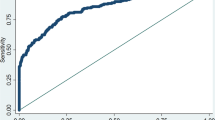Abstract
Objective
To determine the diagnostic accuracy of Indian Scale for Assessment of Autism (ISAA) in children aged between 2–5 years.
Design
Study of diagnostic accuracy
Setting
Tertiary level hospital, (November 2015–November 2017).
Participants
A consecutive sample of 500 children with suspected Autism (delay or regression of developmental milestones, delay or regression in speech, age-inappropriate understanding, behaviour, play and/or social interaction) was recruited.
Procedure
Each child underwent an expert comprehensive assessment of Autism (reference tool) that included history, observation, examination, diagnostic criteria for Autism Spectrum Disorder (ASD) of the Diagnostic and Statistical Manual of Mental Disorders’, 5th edition, Childhood Autism Rating Scale-2 (CARS2), developmental status and adaptive function. This was followed by the administration of ISAA (test tool) in Hindi language. Parameters of diagnostic accuracy and Receiver Operating Characteristic curves were computed.
Main Outcome Measures
ASD based on (i) expert assessment, (ii) CARS-2, and (iii) ISAA.
Results
In children aged 2–3 years, sensitivity of ISAA was 100% (95% CI 98.2% −100%), specificity 28.9% (95% CI 17.7% to 43.4%), positive likelihood ratio 1.4 and negative likelihood ratio 0. In 3–5 year olds, sensitivity was 99.6% (95% CI 97.6% to 99.6%), specificity 33.3% (95% CI 15.1% to 58.3%), positive likelihood ration 1.5 and negative likelihood ratio 0.01. The degrees of autism based on the existing cut off values were inaccurate.
Conclusions
ISAA has sub-optimal performance in diagnosing and assessing severity in 2–5 year old children.
Similar content being viewed by others
References
Arora NK, Nair MKC, Gulati S, Deshmukh V, Mohapatra A, Mishra D, et al. Neurodevelopmental disorders in children aged 2–9 years: Population-based burden estimates across five regions in India. Available from: https://doi.org/10.1371/journal.pmed.1002615 . Accessed August 10, 2018.
MoHFW. National mental health survey of India, 2015–2016: summary. Available from: http://indianmhs.nimhans.ac.in/Docs/Summary.pdf . Accessed January 1, 2019.
Elder JH, Kreider CM, Brasher SN, Ansell M. Clinical impact of early diagnosis of autism on the prognosis and parent-child relationships. Psychol Res Behav Manag. 2017;10:283–92.
Mukherjee SB, Malhotra MK, Aneja S, Chakraborty S, Deshpande S. Diagnostic accuracy of Indian scale for assessment of autism (ISAA) in children aged 2–9 years. Indian Pediatr. 2015,52:212–16.
Volkmar F, Siegel M, Woodbury-Smith M, King B, McCracken J, State M, et al. Practice Parameter for the Assessment and Treatment of Children and Adolescents with Autism Spectrum Disorder. J Am Acad Child Adolesc Psychiatry 2014;53:237–57.
Ministry of Social Justice and Empowerment. Scientific Report on Research Project for Development of Indian Scale for Assessment of Autism. New Delhi: Government of India; 2009.
Juneja M, Mishra D, Russell P, Gulati S, Deshmukh V, Tudu P, et al. INCLEN diagnostic tool for Autism Spectrum Disorder (INDT-ASD): Development and validation. Indian Pediatr. 2014;51:359–65.
Ministry of Social Justice and Empowerment. The National Trust for Welfare of Persons with Autism, Cerebral Palsy, Mental Retardation and Multiple Disability, The National Trust Regulations, 2001. Available from: www.socialjustice.nic.in . Accessed June 23, 2014.
Notification: Guidelines for evaluation and assessment of Autism and procedure for certification. The Gazette of India, Extraordinary 2016 Apr 25; New Delhi: p. 1 (sec 1).
Press Information Bureau, Government of India, MOSJE, 31st August, 2016. National Workshop for Training Master Trainers in Autism Tools INCLEN and ISAA begins. Available from: http://pib.nic.in/newsite/mbErel.aspx.relid.149368 . Accessed November 19, 2016.
Dalwai S, Ahmed S, Udani VU, Mundkur N, Kamath SS, Nair MKC, et al. Consensus Statement on Evaluation and Management of Autism Spectrum Disorder. Indian Pediatr. 2017 54:385–93.
Patra S, Arun P. Use of Indian Scale for Assessment of Autism in Child Guidance Clinic: An Experience. Indian J Psychol Med. 2011:33;217–9.
Raina SK, Kashyap V, Bhardwaj AK, Kumar D, Chander V. Prevalence of autism spectrum disorders among children (1–10 years of age)- Findings of a mid-term report from Northwest India. J Postgrad Med. 2015;61:243–6.
Chakraborty S, Thomas P, Bhatia T, Nimgaonkar VL, Deshpande SN. Assessment of Severity of Autism Using the Indian Scale for Assessment of Autism. Indian J Psychol Med. 2015:37;169–74.
Perumal V, Lekhra OP. Measurement of behavioural characteristics of children with autism spectrum disorders using Indian Scale for Assessment of Autism (ISAA). IJMRME 2017;3:37–45.
Alpern GD. Developmental Profile 3 (DP-3). Los Angeles, CA: Western Psychological Services; 2007.
Sparrow SS, Cicchetti VD, Balla AD. Vineland™ II, Vineland Adaptive Behavior Scales, 2nd ed. Bloomington: Psychcorp, Pearson Inc.; 2005.
American Psychiatry Association. Diagnostic and Statistical Manual of Mental Disorders, 5th ed. Arlington, VA: American Psychiatric Publishers; 2013.
Schopler E, ME Van Bourgondien, Wellman GJ, Love SR. The Childhood Autism Rating Scale, 2nd ed. Torrance, CA: Western Psychological Services, Inc; 2010.
Acknowledgements
Dr Dipti Kapoor who helped in evaluation, and Ms Chetna Pal for managing study data.
Funding
Funding: None; Competing interests: None stated.
Author information
Authors and Affiliations
Contributions
Contributors: SBM, SA: conceptualized the study. SBM, SA, SS: were the neuro-developmental experts; SBM: performed the comprehensive evaluation and quality check; MS: helped in collection and analysis of the data pertaining to ISAA; SBM: carried out the literature search, interpreted the data and drafted the manuscript which underwent a critical appraisal by SA, SS and MS. All the authors approved the final version of manuscript, and agree to be held accountable for all aspects of the work.
Corresponding author
Rights and permissions
About this article
Cite this article
Mukherjee, S.B., Aneja, S., Sharma, S. et al. Diagnostic Accuracy of Indian Scale for Assessment of Autism in Indian Children Aged 2–5 Years. Indian Pediatr 56, 831–836 (2019). https://doi.org/10.1007/s13312-019-1608-1
Received:
Revised:
Accepted:
Published:
Issue Date:
DOI: https://doi.org/10.1007/s13312-019-1608-1




